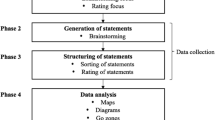Abstract
This paper describes a research project, “Voices from Manukau”, that investigated the impact of a joint initiative by a university and an institute of technology in New Zealand. The purpose of the initiative was to increase the participation of students traditionally under represented at tertiary-level study, particularly Māori (indigenous people) and individuals from Pacific Island nations. Many of the participants were adults who had not experienced high levels of success during their compulsory period of education and they lived in low socio-economic areas. We found that participation of under-represented groups increased. The “Manukau” students were as successful as other undergraduate students studying at the university. Of particular interest was the high level of success of Māori and Pacific Island students.
Similar content being viewed by others
References
Boekaert, M. (2005). Self-regulation: With a focus on the self-regulation of motivation and effort. In I. E. Sigel & K. A. Renninger (Eds.), Handbook of child psychology (6th ed., Vol. 4, Child psychology in practice, pp. 417–451). New York: Wiley.
Bourdieu, P. (2000). In other words: Essays towards a reflexive sociology. Cambridge, UK: Polity Press.
Braxton, J. (Ed.). (2000). Reworking the student departure puzzle. Nashville, TN: Vanderbilt University Press.
Buchanan, I. (1993). Extraordinary spaces in ordinary places: de Certeau and the spaces of postcolonialism. Journal of the South Pacific Association for Commonwealth Literature and Language Studies, 36.
Carnevale, A., & Rose, S. (2003). Socioeconomic status, race/ethnicity and selecting college admissions. New York: The Century Foundation.
Corno, L. (2004). Work habits and work styles: Volition in education. Teachers College Record, (106), 1669–1694.
Crozier, G., Reay, D., Clayton, J., Colliander, L., & Grinstead, J. (2008). Different strokes for different folks: Diverse students in diverse institutions—experiences of higher education. Research Papers in Education, 23(2), 167–177.
de Certeau, M. (1984). The practice of everyday life (S. Rendell, Trans.). Berkley & Los Angeles: University of California Press.
Freire, P. (1972). Pedagogy of the oppressed. Harmondsworth: Penguin.
George, R. (1998). Older women training to teach. Gender and Education, 10(4), 417–430.
Griffiths, V. (2002). Crossing boundaries: The experiences of mature student mothers in initial teacher education. International Journal of Inclusive Education, 6(3), 267–285.
Griffiths, V. (2007). Experience of training on an employment-based route into teaching in England. Journal of In-service Education, 33(1), 107–123.
Hockey, J. (1993). Research methods: Researching peers and familiar settings. Research Papers in Education, 8(2), 199–225.
Hughes, J., Jewson, N., & Unwin, L. (2007). Communities of practice: A contested concept in flux. In J. Hughes, N. Jewson, & L. Unwin (Eds.), Communities of practice. New York: Routledge.
Lave, J., & Wenger, E. (1991). Situated learning: Legitimate peripheral participation. Cambridge: University of Cambridge Press.
Leathwood, C. (2006). Gender, equity and the discourse of the independent learner in higher education. Higher Education, 52, 611–633.
McInnes, C., Hartley, R., Polesel, J., & Teese, R. (2000). Non-completion in vocational education and training and higher education. Canberra: Department of Employment Education Training and Youth Affairs.
Moreau, M., & Leathwood, C. (2006). Balancing paid work and studies: Working (-class) students in higher education. Studies in Higher Education, 31(1), 23–42.
Reay, D. (2001). Finding or losing yourself? Working class relationships to education. Journal of Educational Policy, 16(4), 333–346.
Reay, D., Ball, S., & David, M. (2002). ‘It’s taking me a long time but I’ll get there in the end’: Mature students on access courses and higher education choice. British Educational Research Journal, 28(1), 5–19.
Rio, N., & Stephenson, M. (2010). Agency and Transformation: Pasifika Teachers navigating the currents of change. Mai Review, 1, 1–10. http://www.review.mai.ac.nz.
Robson, J. (2002). Real world research (2nd ed.). Oxford: Blackwell.
Scott, D. (2005). Retention, completion and progression in tertiary education in New Zealand. Journal of Higher Education, Policy and Management, 27(1), 3–17.
Strauss, A. L., & Corbin, J. (1998). Basics of qualitative research: Techniques and procedures for developing grounded theory (2nd ed.). London: Sage Publications.
Tinto, V. (1975). Dropout from higher education: A theoretical synthesis of recent research. Review of Educational Research, 45(1), 89–125.
Tinto, V. (1982). Limits of theory and practice in student attrition. Journal of Higher Education, 53, 687–700.
Tinto, V. (1993). Leaving college: Rethinking the causes and cures of student attrition (2nd ed.). Chicago, IL: The University of Chicago Press.
Tinto, V. (1997). Classrooms as communities. Journal of Higher Education, 68(6), 599–623.
Tinto, V. (2003). Learning better together: The impact of learning communities on student success. Higher Education Monograph Series (1), 1–8.
Wenger, E. (1998). Communities of practice. Cambridge: Cambridge University Press.
Wenger, E. (2007). Communities of practice: A brief introduction. Communities of practice. http://www.ewenger.com/theory/. Accessed November 15, 2010.
Wenger, E., & Snyder, W. (2000). Communities of practice: The organizational frontier. Harvard Business Review, 78(1), 139–145.
Yorke, M. (1999). Leaving early: Undergraduate non-completion in higher education. London: Falmer Press.
Zepke, N., & Leach, L. (2007). Improving student learning outcomes in higher education: New Zealand teachers’ views on teaching students from diverse backgrounds. Teaching in Higher Education, 12(5), 655–668.
Acknowledgments
This research was supported by grants from the Woolf Fisher Research Centre, Auckland, New Zealand.
Author information
Authors and Affiliations
Corresponding author
Rights and permissions
About this article
Cite this article
Millward, P., Stephenson, M.S., Rio, N. et al. Voices from Manukau: recruitment and success of traditionally under represented undergraduate groups in New Zealand. Asia Pacific Educ. Rev. 12, 279–287 (2011). https://doi.org/10.1007/s12564-010-9139-4
Received:
Revised:
Accepted:
Published:
Issue Date:
DOI: https://doi.org/10.1007/s12564-010-9139-4



